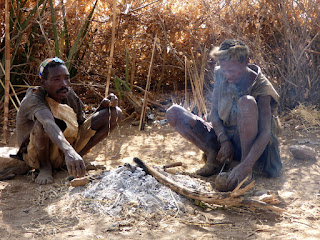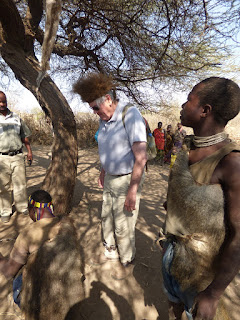We left at 6:15 this morning for the 2 hour drive over bad
roads to two of the tribes in the area. The first, Hadzabe, are also known as
bushmen and live a life not much
different than 500 years ago and speak a click-based language. Today they wear
shirts and shorts under their baboon skins and make money by sharing their
culture -- there were a couple other groups there when we visited. They also use metal tips on some of their arrows and we saw a metal bowl among their possessions. There are
only about a thousand of them left and the feeling was that they will be gone
in a generation or two. The local guides, who have the most contact with them, are trying to get their kids into school, but with their nomadic life, it is hard to see how this will work.
They eat python, kudu, impala, and baboons and anything they can gather. They never eat
hyena because in the past, instead of burying the dead, they set them out for
hyenas to eat and considered the hyena their friends. Now, however, they bury
their dead. They are monogamous, but the wives can chose to swap mates if they
wish.
 |
| Baobab tree |
 |
| Inside of baobab fruit. Slightly sweet and tasty but a dry texture. |
 |
Python skin above and horns and baboon
skulls below which appear to be decorative
elements in their group living room seen above. |
 |
| Decorated bows hang in the group living room |
 |
| The women and children in this small group. |
 |
| Random branches are used to store their minimal belongings. |
 |
| Our interface with this tribe. He was quite the showman. |
 |
| Sitting in his family's dry season living space. |
 |
| This boy was carrying a cooked dik-dik head. |
 |
Our leader used his knife to slice off and
eat chunks with the boy. |
We danced with them, watched them make fire, tried out their bows (I
could shoot far but not accurate...), and visited a baobab tree they live in when
it rains. The trees are naturally hollow, and they opened a hole in the side to
get access. Another tree has a hole at a branch joint, and they scale it to get
the water that fills it.
 |
They have a two-stringed violin, but the music
is not tuneful to my ears. |
 |
| Dancing -- Jim got a baboon headdress and bells around one ankle. |
 |
| Baobab that supplies water from that hole above. |
 |
| Looking out from the tree entry |
 |
I went inside (getting in was easier than out) and took this.
The floor is a couple feet lower than the ground outside. They
did not hollow out the tree, it grows like this. |
 |
Pegs in the tree to hang stuff on, to ease the
climb up, and to use as handles toe enter. The
yellow thing is a soft scrubby for cleaning skin. |
 |
| Previous wet-season homes |
The next tribe was the Dagota, a polygamous group that is
somewhat more modern, though they still live in the simple type of house
similar to Masai. They are herders, but also iron workers and showed us how to
make metal arrow heads from large surplus nails which the nearby Hadzabe We also saw how to melt scrap metal and mold it to make the
starting point for things like bracelets.
 |
David, our guide, with three wives and children. The girl holding
the baby is the eldest daughter. |
 |
| Inside of the living room, demonstrating grinding corn. |
 |
| I tried my hand at grinding and did ok. |
 |
| These brothers work together. The one on the right is still learning. |
 |
| Metal working |
We had a long afternoon off to relax before our all day
drive tomorrow to go to the Serengeti.
 |
The view from our tent. It looks more like some parts
of Wisconsin than Africa. This area has more large
scale farming than we have seen elsewhere. |



























No comments:
Post a Comment